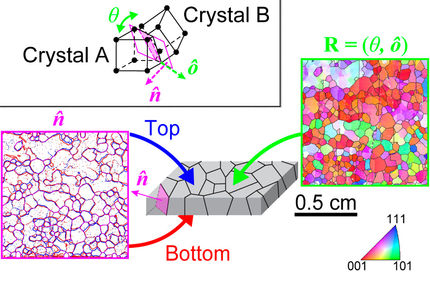Scientists Unlock the Secrets of Nitrogen’s Solid Phase
Unprecedented insights into the gradual molecular-to-polymeric transformation of nitrogen and the formation of amorphous nitrogen
In a ground-breaking study led by the University of Bayreuth researchers, in collaboration with scientists from the University of Edinburgh, UK, and the University of Linköping, Sweden, the mysteries of nitrogen’s solid phases were solved, shedding light on its complex behaviour. Their findings, published in the journal Nature Communications, provide unprecedented insights into the gradual molecular-to-polymeric transformation of nitrogen and the formation of amorphous nitrogen. This paves the way for advances in materials science and high-pressure physics.
At ambient pressure and temperature, nitrogen is gas and is found in the form of an N₂ molecule (N≡N) composed of an extremely strong triple-bond. When extreme pressures are applied to molecular gaseous nitrogen, it first becomes liquid and then a solid at about 2.5 GPa (i.e. 25,000 times the atmospheric pressure). For over a century, scientists have delved into solid phases of molecular nitrogen, asnowledge of the chemico-physical mechanisms underpinning transformations in nitrogen is vital in testing and refining theories of solid-state sciences.
The Zeta-N₂phase of nitrogen, existing between 60 and 115 GPa, is a critical piece of the puzzle for understanding nitrogen’s molecular to polymeric transition. However, despite a large number of investigations, its crystal structure (i.e. the nitrogen molecules’ arrangement) was hitherto unknown—and key to deciphering nitrogen’s odd behaviour. The research team, led by Dominique Laniel (University of Edinburgh) and Natalia Dubrovinskaia and Leonid Dubrovinsky (the University of Bayreuth) employed an experimental technique newly developed in Bayreuth to successfully determine the crystal structure of Zeta-N2. The researchers squeezed molecular nitrogen in diamond anvil cells to extreme pressures between 60 and 85 GPa, such as those prevailing in the Earth's mantle. By applying laser heating up to 2000 degrees Celsius, they were able to recrystallize high-quality submicrometer-size grains of Zeta-N₂. Their crystal structure was solved and refined from synchrotron single-crystal X-ray diffraction. With these experimental findings in hand, theoreticians at the University of Linköping (Sweden) gained further insights into nitrogen’s unique polymerization process.
The implications of this research extend beyond nitrogen itself, offering a deeper understanding of molecular transformations under extreme conditions. The findings pave the way for advancements in solid-state sciences, materials science and high-pressure physics. The researchers improve the methods of studying the properties of functional materials used in electronics, computer chips, semiconductors, solar cells, batteries, lighting, metals or insulators.
Original publication
Dominique Laniel, Florian Trybel, Andrey Aslandukov, James Spender, Umbertoluca Ranieri, Timofey Fedotenko, Konstantin Glazyrin, Eleanor Lawrence Bright, Stella Chariton, Vitali B. Prakapenka, Igor A. Abrikosov, Leonid Dubrovinsky, Natalia Dubrovinskaia; "Title: Structure determination of ζ-N2 from single-crystal X-ray diffraction and theoretical suggestion for the formation of amorphous nitrogen"; Nature Communications, Volume 14, 2023-10-5
Original publication
Dominique Laniel, Florian Trybel, Andrey Aslandukov, James Spender, Umbertoluca Ranieri, Timofey Fedotenko, Konstantin Glazyrin, Eleanor Lawrence Bright, Stella Chariton, Vitali B. Prakapenka, Igor A. Abrikosov, Leonid Dubrovinsky, Natalia Dubrovinskaia; "Title: Structure determination of ζ-N2 from single-crystal X-ray diffraction and theoretical suggestion for the formation of amorphous nitrogen"; Nature Communications, Volume 14, 2023-10-5
Organizations
Other news from the department science

Get the chemical industry in your inbox
By submitting this form you agree that LUMITOS AG will send you the newsletter(s) selected above by email. Your data will not be passed on to third parties. Your data will be stored and processed in accordance with our data protection regulations. LUMITOS may contact you by email for the purpose of advertising or market and opinion surveys. You can revoke your consent at any time without giving reasons to LUMITOS AG, Ernst-Augustin-Str. 2, 12489 Berlin, Germany or by e-mail at revoke@lumitos.com with effect for the future. In addition, each email contains a link to unsubscribe from the corresponding newsletter.





























































